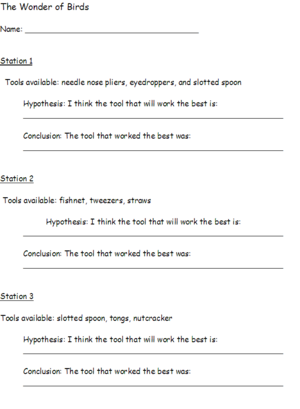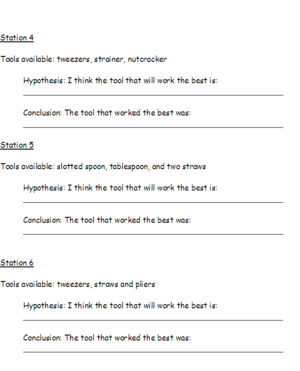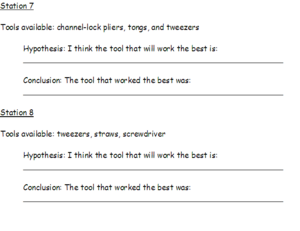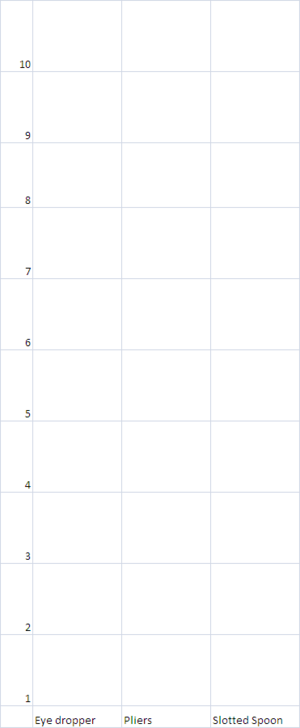The Wonder of Birds
| Instant wiki maker | Making handouts | Editing tips |
Contents
- 1 Exploring the Uses of Beaks
- 1.1 Student worthiness
- 1.2 Primary biological content area covered
- 1.3 Materials
- 1.4 Handouts
- 1.5 Description of activity
- 1.6 Lesson plan
- 1.7 Potential pitfalls
- 1.8 Math connections
- 1.9 Literature connections
- 1.10 Cooking Connection
- 1.11 Connections to educational standards
- 1.12 Next steps
- 1.13 Reflections
- 1.14 Citations and links
Biology In Elementary Schools is a Saint Michael's College student project from a course that ran between 2007 and 2010. The student-created resources have been preserved here for posterity. Link under 'toolbox' for printer-friendly versions of the exercises. Click on handouts to print full resolution versions. Please see Wikieducator's disclaimer, our safety statement, and the Creative Commons licensing in English and in legalese.
Exploring the Uses of Beaks
Student worthiness
Brand new and untested.
Primary biological content area covered
Categorizing types of bird beaks and their uses in the wild for survival. Also, natural selection, adaptation, and evolution.
Materials
- Rubber erasers
- Pliers (needle nose, channel lock pliers)
- Straw
- Slotted spoon (3)
- Envelope or fishnet
- Tweezers (4)
- Chopsticks (2)
- Nutcracker (2)
- Tongs (2)
- Strainer
- Straws
- Screwdriver
- A whole walnut
- Beads on a string
- Tiny marshmallows (2)
- Un-cooked Rice
- Small container w/opening
- Bread
- Bowl (2)
- Gummy worms
Handouts
These handouts can easily be printed off of the website. Please feel free to use them. Note: If you have a class with English Language Learners it may be useful to add pictures of the tools to the worksheet. The last 'handout' is a sample of the type of graph that we had at each station for the students to chart their results. Each graph had the tools for each station at the bottom.
Description of activity
This activity will explore the uses of birds beaks in the wild. The activity features 8 stations in which students will hypothesize, test, and record the data they observe. This is a hands-on and interactive experiment that the students are sure to enjoy.
Lesson plan
In this activity, student will be divided into eight separate groups. Each group will travel to eight different stations set up around the room. At each station, students will use three different tools that will represent different types of birds beaks. The students will use the tools to determine which type of beak is best for different types of birds to survive in their habitat. At each station the students will hypothesize about which 'beak' will work the best to attain the food. After they test the different 'beaks' the students will graph which one worked the best. Each station will also have pictures of the birds that have that specific type of beak.
- At the first station, students will use needle nose pliers, eyedroppers, and slotted spoons in order to try and pick up rubber erasers in a small container of water. The tools will represent different types of birds beaks, and the rubber erasers in the water represent fish in shallow water. From using these tools students will discover which type of bird beak is best used for catching fish.
- At the second station, the teacher will toss popcorn or small marshmallows into the air to represent flying insects. Students will use fishnets, tweezers, and chopsticks to try and catch the flying insects. From using these tools, studetns will discover which type of bird beak is best for catching flying insects.
- At the third station, students will use a nutcracker, tongs, and slotted spoons to open up walnuts and other hard shell nuts. The nuts will represent seeds, so from these tools, students will be able to discover which type of birds beak is best used for seed eating.
- At the fourth station, students will use tweezers, strainers, and a nutcracker to try and catch grapes hanging from a string. The grapes are meant to represent fruit hanging from a tree, so students will discover which type of birds beak is best used for fruit eating.
- At the fifth station, students will use slotted spoons, tablespoons, and chop sticks to pick out tiny marshmallows from a big container. The marshmallows represent aquatic plants and animal, so students will discover which type of birds beak is best used for water and mud shifting.
- At the sixth station, students will use tweezers, straws and pliers to pick out rice scattered in a small log with a hole. (An empty paper towel role with small holes works just as well.) The rice will represent insects in a hollow tree, so students will discover which tool best represents a chisel beak.
- At the seventh station, students will use channel-lock pliers, tongs, and tweezers to pick up a single piece bread. The bread will represent mice or small animals, so students will discover which birds beak is best used for preying.
- At the eighth station, students will use forceps, tweezers, and straws to pick up gummy words in oatmeal. The worms represent worms buried in mud, so students will discover which tool is best used to represent a probing beak.
Assessment: The students will be assessed on the information they learned by using the worksheet.(see figure 1) This will have then match the bird to its beak and write in the type of food that it would eat.
Potential pitfalls
This project does have a few pitfalls. There could be some food allergies to the nuts or to the candy. We changed the walnut to a sunflower seed to avoid the allergy issue. The stations do have a tendency to get messy so you'll need adult supervision at most stations. There are also space constrictions, there must be enough room to spread the stations out.
Math connections
The students will be graphing at each station, this could be connected to a larger collection of data unit or a graphing unit.
Literature connections
Any children's book connected with birds or outdoor life could be used to enhance this lesson. An alternate book could also be one about natural selection. We did not have a specific book.
Cooking Connection
A great way to 'reward' your students after a great lesson is with food. These are extremely easy to make and require nothing but a refrigerator. I can remember making them when I was little. The ingredients are simple and require no cooking,just melting. Once the cookies are shaped you can put jelly beans in the center to simulate bird's eggs. The recipe is linked at the bottom of this section. The website is full of other ideas if you have allergies to the ingredients. This particular recipe is great because the students could participate in the process.
Connections to educational standards
VT Standard: Scientific Inquiry
- GLE: S(3-4):2: Students demonstrate their understanding of the scientific method by predicting and hypothesizing.
- GLE: S(3-4):4: Students demonstrate their ability to represent data collected in a graph format; following a detailed plan of investigation; recording data and observations during the experiment
- GLE: S(3-4):5:Students demonstrate their ability to represent data by organizing a collection of data into a table or a graph template.
Next steps
This project can easily be used in a large bird unit. You could have students demonstrate natural selection by having them compete for the same resource. This is a great way to have students actually participate in the process. You could also apply this into a bird observation unit. You could take the class outside and have them observe the native birds in the area and how they survive. This could also be a 'house' project where more than one class gets involves and they can compare the birds and behaviors they found.
Reflections
Celia: This project went very well. The set up was a bit intensive for such a small area but it worked out all right. This activity would be much better suited for large stations around the classroom. The skills that students use in this experiment are vast. They learn to create and test a hypothesis. They also learn that it's okay if the hypothesis is not correct. It's still science. The students loved the idea of traveling around to each station and that each station was hands on. They wanted to eat the food, we had to tell them no. Perhaps a teacher could making a cooking connection with them. They could create cookies that look like birds nests. This project will fit in will with many different curriculum and I certainly hope to use it in my future classroom.
Montana: I feel that this was an activity that we got the most positive feedback from both the teachers and the students we worked with. The students really had a chance to work on their hypothesizing skills and have a hands on experience with results that varied from their original guess, proving the positive effects of experimentation. The students were extremely occupied the entire time and the teachers seemed to be very pleased and blown away by our idea and the effectiveness of it. I would most defiantly use this in my own classroom, for it is informative, uses concentration, and demonstrates all of the components of a science experiment.
Lindsay: I think that this was a great activity to use in the classroom. The students loved to use the tools and participate in each station. It was also a great way to have them learn how to hypothesize and make conclusions. I think that this lesson would have worked better if we had pictures of the birds with the right type of beak at each station, that way the students could connect what they were learning to the type of birds beak more easily. However, many students did make the connection rather easily and greatly enjoyed each station. I think this lesson was overall very successful and the students had a lot of fun doing it.
Citations and links
[2] This is the website where we adapted our idea from.















